ListBox
列表框 UI 组件
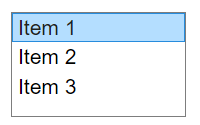
说明
列表框 UI 组件允许 App 用户从列表中选择选项。在创建列表框后,使用 ListBox 对象修改其外观和行为。
创建对象
使用 uilistbox 函数在 App 中创建一个列表框。
属性
列表框
值,指定为 Items 数组或 ItemsData 数组的元素,或指定为空元胞数组。默认情况下,Value 是 Items 中的第一个元素。
要不指定任何选择,请将 Value 设置为空元胞数组。
将 Value 指定为 Items 的元素,即可选择与该元素匹配的列表项。如果 ItemsData 非空,则 Value 必须设置为 ItemsData 的元素,而列表框将选中列表中的关联项目。
列表框项目,指定为字符向量元胞数组、字符串数组或一维分类数组。允许重复的元素。列表框显示的选项与 Items 数组中的元素数量一样多。如果将此属性指定为分类数组,MATLAB® 将使用数组中的值,而不是完整的类别集。
与 Items 属性值的每个元素关联的数据,指定为 1×n 数值数组或 1×n 元胞数组。允许重复的元素。
例如,如果您将 Items 值设置为员工姓名,则可以将 ItemsData 值设置为对应的员工 ID 号。ItemsData 值对 App 用户不可见。
如果 ItemsData 值和 Items 值中的数组元素数量不匹配,将发生以下情况之一:
如果
ItemsData值为空,则Items值的所有元素都呈现给 App 用户。如果
ItemsData值中的元素数大于Items值,则Items值的所有元素都呈现给 App 用户。MATLAB 将忽略多余的ItemsData元素。如果
ItemsData值非空,但元素数少于Items值,只将在ItemsData值中具有对应元素的Items值的元素呈现给 App 用户。
示例: {'One','Two','Three'}
示例: [10 20 30 40]
项目或项目数据列表中组件值的索引,指定为正整数。
要不指定任何选择,请将 ValueIndex 设置为空数组 ([])。
在大多数情况下,您可以使用 Value 属性来查询和更新组件值。但是,当 Items 和 ItemsData 属性都非空时,ValueIndex 属性会很有用。在这种情况下,您可以使用 ValueIndex 属性来查询与当前值对应的 Items 的元素。
fig = uifigure; lb = uilistbox(fig, ... "Items",["Red","Green","Blue"], ... "ItemsData",["#F00","#0F0","#00F"]); idx = lb.ValueIndex; disp(lb.Items(idx) + ": " + lb.Value)
Red: #F00
字体和颜色
字体名称,指定为系统支持的字体名称。默认字体取决于具体操作系统和区域设置。
如果指定的字体不可用,MATLAB 将使用运行 App 的系统上的可用字体中的最佳匹配项。
示例: 'Arial'
字体大小,指定为正数。测量单位为像素。默认字体大小取决于具体操作系统和区域设置。
示例: 14
字体粗细,指定为下列值之一:
'normal'- 特定字体定义的默认粗细'bold'- 字符轮廓比'normal'粗
并非所有字体都有加粗字体。对于非加粗字体,指定 'bold' 会得到普通字体。
字体角度,指定为 'normal' 或 'italic'。并非所有字体都有倾斜字体角度。对于无斜体字体,指定 'italic' 后会使用常规字体角度。
字体颜色,指定为 RGB 三元组、十六进制颜色代码或下表中列出的选项之一。
RGB 三元组和十六进制颜色代码对于指定自定义颜色非常有用。
RGB 三元组是包含三个元素的行向量,其元素分别指定颜色中红、绿、蓝分量的强度。强度值必须位于
[0,1]范围内,例如[0.4 0.6 0.7]。十六进制颜色代码是字符向量或字符串标量,以井号 (
#) 开头,后跟三个或六个十六进制数字,范围可以是0到F。这些值不区分大小写。因此,颜色代码"#FF8800"与"#ff8800"、"#F80"与"#f80"是等效的。
此外,还可以按名称指定一些常见的颜色。下表列出了命名颜色选项、等效 RGB 三元组和十六进制颜色代码。
| 颜色名称 | 短名称 | RGB 三元组 | 十六进制颜色代码 | 外观 |
|---|---|---|---|---|
"red" | "r" | [1 0 0] | "#FF0000" |
|
"green" | "g" | [0 1 0] | "#00FF00" |
|
"blue" | "b" | [0 0 1] | "#0000FF" |
|
"cyan" | "c" | [0 1 1] | "#00FFFF" |
|
"magenta" | "m" | [1 0 1] | "#FF00FF" |
|
"yellow" | "y" | [1 1 0] | "#FFFF00" |
|
"black" | "k" | [0 0 0] | "#000000" |
|
"white" | "w" | [1 1 1] | "#FFFFFF" |
|
下表列出了浅色和深色主题中绘图的默认调色板。
| 调色板 | 调色板颜色 |
|---|---|
在 R2025a 之前的版本中: 大多数绘图默认使用这些颜色。 |
|
|
|
您可以使用 orderedcolors 和 rgb2hex 函数获取这些调色板的 RGB 三元组和十六进制颜色代码。例如,获取 "gem" 调色板的 RGB 三元组并将其转换为十六进制颜色代码。
RGB = orderedcolors("gem");
H = rgb2hex(RGB);在 R2023b 之前的版本中: 使用 RGB = get(groot,"FactoryAxesColorOrder") 获取 RGB 三元组。
在 R2024a 之前的版本中: 使用 H = compose("#%02X%02X%02X",round(RGB*255)) 获取十六进制颜色代码。
背景颜色,指定为 RGB 三元组、十六进制颜色代码或下表中列出的颜色选项之一。
RGB 三元组和十六进制颜色代码对于指定自定义颜色非常有用。
RGB 三元组是包含三个元素的行向量,其元素分别指定颜色中红、绿、蓝分量的强度。强度值必须位于
[0,1]范围内,例如[0.4 0.6 0.7]。十六进制颜色代码是字符向量或字符串标量,以井号 (
#) 开头,后跟三个或六个十六进制数字,范围可以是0到F。这些值不区分大小写。因此,颜色代码"#FF8800"与"#ff8800"、"#F80"与"#f80"是等效的。
此外,还可以按名称指定一些常见的颜色。下表列出了命名颜色选项、等效 RGB 三元组和十六进制颜色代码。
| 颜色名称 | 短名称 | RGB 三元组 | 十六进制颜色代码 | 外观 |
|---|---|---|---|---|
"red" | "r" | [1 0 0] | "#FF0000" |
|
"green" | "g" | [0 1 0] | "#00FF00" |
|
"blue" | "b" | [0 0 1] | "#0000FF" |
|
"cyan" | "c" | [0 1 1] | "#00FFFF" |
|
"magenta" | "m" | [1 0 1] | "#FF00FF" |
|
"yellow" | "y" | [1 1 0] | "#FFFF00" |
|
"black" | "k" | [0 0 0] | "#000000" |
|
"white" | "w" | [1 1 1] | "#FFFFFF" |
|
下表列出了浅色和深色主题中绘图的默认调色板。
| 调色板 | 调色板颜色 |
|---|---|
在 R2025a 之前的版本中: 大多数绘图默认使用这些颜色。 |
|
|
|
您可以使用 orderedcolors 和 rgb2hex 函数获取这些调色板的 RGB 三元组和十六进制颜色代码。例如,获取 "gem" 调色板的 RGB 三元组并将其转换为十六进制颜色代码。
RGB = orderedcolors("gem");
H = rgb2hex(RGB);在 R2023b 之前的版本中: 使用 RGB = get(groot,"FactoryAxesColorOrder") 获取 RGB 三元组。
在 R2024a 之前的版本中: 使用 H = compose("#%02X%02X%02X",round(RGB*255)) 获取十六进制颜色代码。
此 属性 为只读。
使用 uistyle 函数创建的所添加样式的配置,以 n×3 表数组形式返回。表数组的每一行对应于当前应用于列表框的一个样式。对连续添加的样式赋予 n+1 的样式顺序号。Target 和 TargetIndex 列指定样式所添加到的列表框部分。Style 列指定样式类名。
如果要使用 removeStyle 函数从列表框中删除样式,请使用此属性。
示例:删除样式
首先,向一个列表框添加两个样式。
fig = uifigure; fig.Position = [100 100 300 250]; lb = uilistbox(fig); s1 = uistyle("FontColor","blue"); s2 = uistyle("FontColor","red"); addStyle(lb,s1,"item",1); addStyle(lb,s2,"item",[2 3 4]);

当您查询 lb.StyleConfigurations 时,MATLAB 返回一个 2×3 表数组。蓝色字体样式首先添加到该列表框中,因此其样式顺序号为 1。级别样式的 TargetIndex 值 {[ 1]} 表示该样式应用于列表框中的第一个项目。同样,第二个样式添加到该列表框.中的最后三个项目。
lb.StyleConfigurations
ans =
2×3 table
Target TargetIndex Style
______ ___________ _________________________
1 item {[ 1]} 1×1 matlab.ui.style.Style
2 item {[2 3 4]} 1×1 matlab.ui.style.Style
通过指定样式顺序号 2 删除添加到列表框中的第二个样式。组件外观更新为仅使用第一个样式。
removeStyle(lb,2)
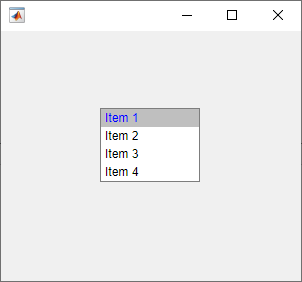
交互性
可见性状态,指定为 'on' 或 'off',或者指定为数值或逻辑值 1 (true) 或 0 (false)。值 'on' 等效于 true,'off' 等效于 false。因此,您可以使用此属性的值作为逻辑值。该值存储为 matlab.lang.OnOffSwitchState 类型的 on/off 逻辑值。
'on'- 显示对象。'off'- 隐藏对象而不删除它。您仍然可以访问不可见 UI 组件的属性。
要使您的 App 更快地启动,请将不需要在启动时出现的所有 UI 组件的 Visible 属性设置为 'off'。
多项目选择,指定为 'off' 或 'on',或者指定为数值或逻辑值 1 (true) 或 0 (false)。值 'on' 等效于 true,'off' 等效于 false。因此,您可以使用此属性的值作为逻辑值。该值存储为 matlab.lang.OnOffSwitchState 类型的 on/off 逻辑值。
如果将此属性设置为 'on',则允许用户同时选择多个项目。
工作状态,指定为 'on' 或 'off',或者指定为数值或逻辑值 1 (true) 或 0 (false)。值 'on' 等效于 true,'off' 等效于 false。因此,您可以使用此属性的值作为逻辑值。该值存储为 matlab.lang.OnOffSwitchState 类型的 on/off 逻辑值。
如果您将此属性设置为
'on',则 App 用户可以与组件进行交互。如果您将此属性设置为
'off',组件将灰显,指示 App 用户无法与其交互,并且它不会触发回调。
工具提示,指定为字符向量、字符向量元胞数组、字符串数组或一维分类数组。如果使用此属性,则在运行时当用户将指针悬停在组件上时,将显示消息。即使禁用组件,工具提示也会显示。要显示多行文本,请指定字符向量元胞数组或字符串数组。数组中的每个元素变为一行文本。如果将此属性指定为分类数组,MATLAB 将使用数组中的值,而不是完整的类别集。
上下文菜单,指定为使用 uicontextmenu 函数创建的 ContextMenu 对象。使用此属性可在您右键点击组件时显示上下文菜单。
位置
列表框相对于父容器的位置和大小,指定为向量 [left bottom width height]。此表介绍该向量中的每个元素。
| 元素 | 描述 |
|---|---|
left | 父容器的内部左边缘与列表框的外部左边缘之间的距离 |
bottom | 父容器的内部下边缘与列表框的外部下边缘之间的距离 |
width | 列表框的左右外部边缘之间的距离 |
height | 列表框的上下外部边缘之间的距离 |
所有测量值都以像素为单位。
Position 值相对于父容器的可绘制区域。可绘制区域是指容器边框内的区域,不包括装饰元素(如菜单栏或标题)所占的区域。
示例: [100 100 100 200]
列表框的内部位置和大小,指定为 [left bottom width height]。位置值相对于父容器。所有测量值都以像素为单位。此属性值等同于 Position 属性值。
此 属性 为只读。
列表框的外部位置和大小,以 [left bottom width height] 形式返回。位置值相对于父容器。所有测量值都以像素为单位。此属性值等同于 Position 属性值。
布局选项,指定为 GridLayoutOptions 对象。此属性为网格布局容器的子级组件指定选项。如果组件不是网格布局容器的子级(例如,它是图窗或面板的子级),则此属性为空且不起作用。但是,如果组件是网格布局容器的子级,则可以通过在 GridLayoutOptions 对象上设置 Row 和 Column 属性,将组件放置在网格的所需行和列中。
例如,以下代码将一个列表框放置在其父网格的第三行第二列中。
g = uigridlayout([4 3]); list = uilistbox(g); list.Layout.Row = 3; list.Layout.Column = 2;
要使该列表框跨多个行或列,请将 Row 或 Column 属性指定为二元素向量。例如,此列表框跨列 2 到 3:
list.Layout.Column = [2 3];
回调
更改值后执行的回调,指定为下列值之一:
函数句柄。
第一个元素是函数句柄的元胞数组。元胞数组中的后续元素是传递到回调函数的参量。
包含有效 MATLAB 表达式的字符向量(不推荐)。MATLAB 在基础工作区计算此表达式。
当用户从列表框中选择不同的项目时,将会执行此回调函数。如果以编程方式更改 Value 属性设置,将不会执行此回调函数。
此回调函数可以访问有关用户与列表框的交互的特定信息。MATLAB 将 ValueChangedData 对象中的此信息作为第二个参量传递给回调函数。在 App 设计工具中,该参量名为 event。您可以使用圆点表示法查询对象属性。例如,event.PreviousValue 返回列表框的上一个值。ValueChangedData 对象不可用于指定为字符向量的回调函数。
下表列出了 ValueChangedData 对象的属性。
| 属性 | 值 |
|---|---|
Value | App 用户最近一次交互之后列表框的值 |
PreviousValue | App 用户最近一次交互之前列表框的值 |
ValueIndex | App 用户最近一次交互之后项目中列表框值的索引 |
PreviousValueIndex | App 用户最近一次交互之前项目中列表框值的索引 |
Source | 执行回调的组件 |
EventName | 'ValueChanged' |
有关编写回调的详细信息,请参阅App 设计工具中的回调。
点击后的回调,指定为下列值之一:
函数句柄。
第一个元素是函数句柄的元胞数组。元胞数组中的后续元素是传递到回调函数的参量。
包含有效 MATLAB 表达式的字符向量(不推荐)。MATLAB 在基础工作区计算此表达式。
当用户点击列表框中的任意位置时,此回调函数执行。
此回调函数可以访问有关用户与列表框的交互的特定信息。MATLAB 将 ClickedData 对象中的此信息作为第二个参量传递给回调函数。在 App 设计工具中,该参量名为 event。您可以使用圆点表示法查询对象属性。例如,event.InteractionInformation 返回有关用户在列表框中点击位置的信息。ClickedData 对象不可用于指定为字符向量的回调函数。
下表列出了 ClickedData 对象的属性。
| 属性 | 值 |
|---|---|
InteractionInformation | 有关 App 用户在组件中点击位置的信息。此信息存储为具有以下属性的对象:
您可以使用圆点表示法查询对象属性。例如, |
Source | 执行回调的组件 |
EventName | 'Clicked' |
下表列出了与列表框组件相关联的 InteractionInformation 对象的属性。
| 属性 | 值 |
|---|---|
Item | 点击的列表框项的索引,以标量形式返回。 如果用户点击了列表框中与项无关的区域,则 |
Location | 用户点击的位置相对于列表框父容器左下角的位置,以
|
ScreenLocation | 用户点击的位置相对于其主显示画面左下角的位置,以
|
有关编写回调的详细信息,请参阅App 设计工具中的回调。
示例:点击列表框时打开窗口
创建一个包含表示颜色的项的列表框。指定名为 openWindow 的 ClickedFcn 回调函数,该函数在用户点击列表框时执行。在 openWindow 函数中:
使用
event.InteractionInformation对象访问有关用户是否点击了某个项的信息。如果用户点击某个项(而不是列表框中与项无关的位置),则会查询用户点击的位置以及与所点击项关联的颜色。
打开新窗口,在用户点击的位置显示项颜色。
要尝试此示例,请将代码保存在新脚本中并运行它。点击列表框中的一个项以打开新窗口。
fig = uifigure; lb = uilistbox(fig); lb.Items = ["Red","Yellow","Blue"]; lb.ItemsData = ["r","y","b"]; lb.ClickedFcn = @openWindow; function openWindow(lb,event) idx = event.InteractionInformation.Item; if ~isempty(idx) p = event.InteractionInformation.ScreenLocation; color = lb.ItemsData(idx); fig2 = uifigure("Position",[p 150 150]); fig2.Color = color; end end
双击回调,指定为下列值之一:
函数句柄。
第一个元素是函数句柄的元胞数组。元胞数组中的后续元素是传递到回调函数的参量。
包含有效 MATLAB 表达式的字符向量(不推荐)。MATLAB 在基础工作区计算此表达式。
当用户双击列表框中的任意位置时,此回调函数执行。
此回调函数可以访问有关用户与列表框的交互的特定信息。MATLAB 将 DoubleClickedData 对象中的此信息作为第二个参量传递给回调函数。在 App 设计工具中,该参量名为 event。您可以使用圆点表示法查询对象属性。例如,event.InteractionInformation 返回有关用户在列表框中双击位置的信息。DoubleClickedData 对象不可用于指定为字符向量的回调函数。
下表列出了 DoubleClickedData 对象的属性。
| 属性 | 值 |
|---|---|
InteractionInformation | 有关 App 用户在组件中点击位置的信息。此信息存储为具有以下属性的对象:
您可以使用圆点表示法查询对象属性。例如, |
Source | 执行回调的组件 |
EventName | 'DoubleClicked' |
下表列出了与列表框组件相关联的 InteractionInformation 对象的属性。
| 属性 | 值 |
|---|---|
Item | 双击的列表框项的索引,以标量形式返回。 如果用户双击了列表框中与项无关的区域,则 |
Location | 用户双击的位置相对于列表框父容器左下角的位置,以
|
ScreenLocation | 用户双击的位置相对于其主显示画面左下角的位置,以
|
有关编写回调的详细信息,请参阅App 设计工具中的回调。
示例:双击列表框时打开窗口
创建一个包含表示颜色的项的列表框。指定名为 openWindow 的 DoubleClickedFcn 回调函数,该函数在用户双击列表框时执行。在 openWindow 函数中:
使用
event.InteractionInformation对象访问有关用户是否双击了某项的信息。如果用户双击某个项(而不是列表框中与项无关的位置),则会查询用户双击的位置以及与所双击项关联的颜色。
打开新窗口,在用户双击的位置显示项颜色。
要尝试此示例,请将代码保存在新脚本中并运行它。双击列表框中的一个项以打开新窗口。
fig = uifigure; lb = uilistbox(fig); lb.Items = ["Red","Yellow","Blue"]; lb.ItemsData = ["r","y","b"]; lb.DoubleClickedFcn = @openWindow; function openWindow(lb,event) idx = event.InteractionInformation.Item; if ~isempty(idx) p = event.InteractionInformation.ScreenLocation; color = lb.ItemsData(idx); fig2 = uifigure("Position",[p 150 150]); fig2.Color = color; end end
对象创建函数,指定为下列值之一:
函数句柄。
第一个元素是函数句柄的元胞数组。元胞数组中的后续元素是传递到回调函数的参量。
包含有效 MATLAB 表达式的字符向量(不推荐)。MATLAB 在基础工作区计算此表达式。
有关将回调指定为函数句柄、元胞数组或字符向量的详细信息,请参阅App 设计工具中的回调。
此属性指定要在 MATLAB 创建对象时执行的回调函数。MATLAB 将在执行 CreateFcn 回调之前初始化所有属性值。如果不指定 CreateFcn 属性,则 MATLAB 执行默认的创建函数。
对现有组件设置 CreateFcn 属性没有任何作用。
如果将此属性指定为函数句柄或元胞数组,则可以使用回调函数的第一个参量访问正在创建的对象。否则,使用 gcbo 函数访问该对象。
对象删除函数,指定为下列值之一:
函数句柄。
第一个元素是函数句柄的元胞数组。元胞数组中的后续元素是传递到回调函数的参量。
包含有效 MATLAB 表达式的字符向量(不推荐)。MATLAB 在基础工作区计算此表达式。
有关将回调指定为函数句柄、元胞数组或字符向量的详细信息,请参阅App 设计工具中的回调。
此属性指定在 MATLAB 删除对象时要执行的回调函数。MATLAB 在销毁对象的属性之前执行 DeleteFcn 回调。如果不指定 DeleteFcn 属性,则 MATLAB 执行默认的删除函数。
如果将此属性指定为函数句柄或元胞数组,则可以使用回调函数的第一个参量访问要删除的对象。否则,使用 gcbo 函数访问该对象。
回调执行控件
回调中断,指定为 'on' 或 'off',或者指定为数值或逻辑值 1 (true) 或 0 (false)。值 'on' 等效于 true,'off' 等效于 false。因此,您可以使用此属性的值作为逻辑值。该值存储为 matlab.lang.OnOffSwitchState 类型的 on/off 逻辑值。
此属性确定是否可以中断运行中回调。有以下两种回调状态要考虑:
运行中回调是当前正在执行的回调。
中断回调是试图中断运行中回调的回调。
每次执行处理回调队列的命令时,MATLAB 都会确定回调中断行为。这些命令包括 drawnow、figure、uifigure、getframe、waitfor 和 pause。
如果运行中回调不包含上述命令之一,则不会发生中断。MATLAB 首先完成执行运行中回调,然后执行中断回调。
如果运行中回调确实包含上述命令之一,则由运行中回调所属对象的 Interruptible 属性来确定是否发生中断:
如果
Interruptible的值为'off',则不会发生中断。此时,由中断回调所属对象的BusyAction属性确定中断回调是被丢弃还是添加到回调队列中。如果
Interruptible的值为'on',则发生中断。下次 MATLAB 处理回调队列时,它会停止运行中回调的执行,并执行中断回调。在中断回调完成后,MATLAB 将继续执行运行中回调。
注意
回调的中断和执行在以下情况下会有不同的表现:
如果中断回调是
DeleteFcn、CloseRequestFcn或SizeChangedFcn回调,则无论是否存在Interruptible属性值都会发生中断。如果运行中回调当前正在执行
waitfor函数,则无论是否存在Interruptible属性值都会发生中断。如果中断回调由
Timer对象所有,则回调将根据调度执行,而不考虑Interruptible属性值。
回调排队,指定为 'queue' 或 'cancel'。BusyAction 属性决定 MATLAB 如何处理中断回调的执行。有以下两种回调状态要考虑:
运行中回调是当前正在执行的回调。
中断回调是试图中断运行中回调的回调。
BusyAction 属性仅在同时满足以下两个条件时才确定回调排队行为:
在这些情况下,由中断回调所属对象的 BusyAction 属性确定 MATLAB 如何处理中断回调。以下是 BusyAction 属性的可能值:
'queue'- 将中断回调放入队列中,以便在运行中回调执行完毕后进行处理。'cancel'- 不执行中断回调。
此 属性 为只读。
删除状态,以 matlab.lang.OnOffSwitchState 类型的 on/off 逻辑值形式返回。
当 DeleteFcn 回调开始执行时,MATLAB 会将 BeingDeleted 属性设置为 'on'。BeingDeleted 属性将一直保持 'on' 设置状态,直到组件对象不再存在为止。
在查询或修改对象之前,请先检查其 BeingDeleted 属性的值,以确认它不是待删除项。
父级/子级
父容器,指定为 Figure 对象或其子容器之一:Tab、Panel、ButtonGroup 或 GridLayout。如果未指定容器,MATLAB 将调用 uifigure 函数以创建一个新 Figure 对象来充当父容器。
对象句柄的可见性,指定为 'on'、'callback' 或 'off'。
此属性控制对象在其父级的子级列表中的可见性。当对象未显示在其父级的子级列表中时,通过搜索对象层次结构或查询属性来获取对象的函数不会返回该对象。这些函数包括 get、findobj、clf 和 close。对象即使在不可见时也有效。如果可以访问某个对象,则可以设置和获取其属性,并将其传递给针对对象进行运算的任意函数。
| HandleVisibility 值 | 描述 |
|---|---|
'on' | 对象始终可见。 |
'callback' | 对象对于回调或回调调用的函数可见,但对于命令行调用的函数不可见。此选项阻止通过命令行访问对象,但允许回调函数访问它。 |
'off' | 对象始终不可见。该选项用于防止另一函数无意中对 UI 进行更改。将 HandleVisibility 设置为 'off' 可在执行该函数时暂时隐藏对象。 |
标识符
此 属性 为只读。
图形对象的类型,以 'uilistbox' 形式返回。
对象标识符,指定为字符向量或字符串标量。您可以指定唯一的 Tag 值作为对象的标识符。如果需要访问您代码中其他位置的对象,可以使用 findobj 函数基于 Tag 值搜索对象。
用户数据,指定为任何 MATLAB 数组。例如,您可以指定标量、向量、矩阵、元胞数组、字符数组、表或结构体。使用此属性存储对象上的任意数据。
如果您在 App 设计工具中工作,请在该 App 中创建公共或私有属性以共享数据,而不是使用 UserData 属性。有关详细信息,请参阅在用 App 设计工具创建的 App 内共享数据。
对象函数
addStyle | Add style to UI component |
removeStyle | 从 UI 组件中删除样式 |
scroll | 滚动到 UI 组件内的位置 |
focus | Give focus to UI component |
示例
在 UI 图窗中创建一个列表框,并指定列表框项目。
fig = uifigure; lb = uilistbox(fig,"Items",["Australia","France","Germany"]);
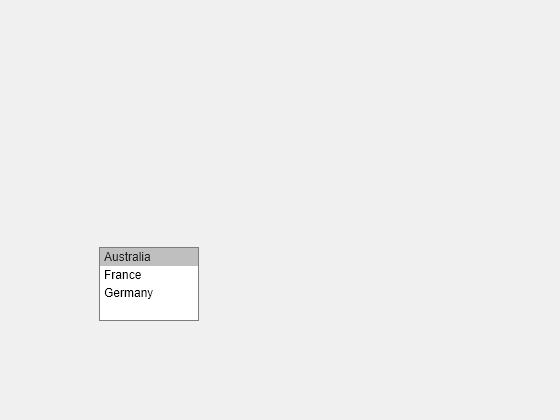
查询所选项目的值。
val = lb.Value
val = 'Australia'
以编程方式更新列表框选择。
lb.Value = "Germany";
在 UI 图窗中创建一个列表框,并通过设置 Items 属性指定一个列表框中的颜色名称列表。
fig = uifigure; lb = uilistbox(fig,"Items",["Red","Green","Blue"]);
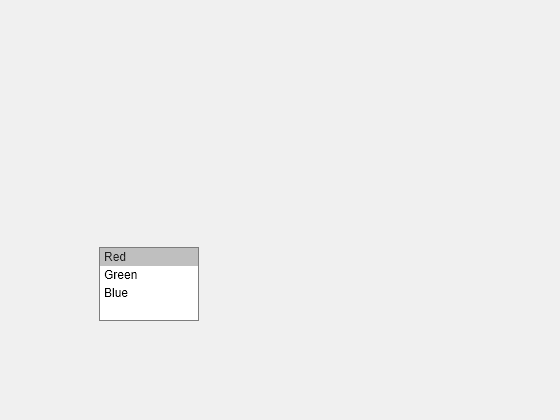
当没有与项目相关联的数据时,列表框的 Value 属性是 Items 中的一个元素。
val = lb.Value
val = 'Red'
通过设置 ItemsData 属性,将十六进制颜色数据与列表框项目相关联。设置 ItemsData 不会更改项目向 App 用户显示的方式。
lb.ItemsData = ["#F00","#0F0","#00F"];

当 ItemsData 属性非空时,列表框的 Value 属性是 ItemsData 中的一个元素。
val = lb.Value
val = "#F00"
指定 ItemsData 有利于更轻松地执行与所选项目相关联的操作。例如,通过将十六进制颜色值直接传递给 plot 函数,用所选颜色绘制一些数据。
plot(1:10,"Color",lb.Value)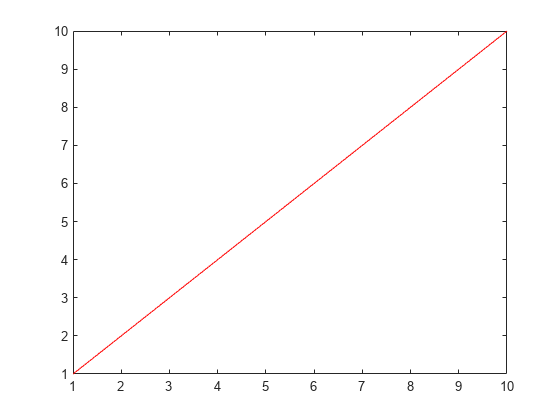
创建一个 App。当用户选择列表框项目时,该 App 会更新颜色图。
在名为 colormapApp.m 的文件中,编写实现该 App 的函数:
创建一个 UI 图窗和一个网格布局管理器,以对该 App 进行布局。
在网格布局管理器中用一些绘制的数据创建一个列表框和 UI 坐标区。
编写一个名为
listBoxValueChanged的回调函数来更新 UI 坐标区的颜色图,并将该函数赋给列表框的ValueChangedFcn回调属性。有关回调的详细信息,请参阅Create Callbacks for Apps Created Programmatically。
function colormapApp fig = uifigure; g = uigridlayout(fig,[3 2]); g.RowHeight = {'1x','fit','1x'}; g.ColumnWidth = {'fit','1x'}; lb = uilistbox(g, ... "Items",["Spring","Summer","Autumn","Winter"], ... "ItemsData",{spring,summer,autumn,winter}); lb.Layout.Row = 2; lb.Layout.Column = 1; ax = uiaxes(g); ax.Layout.Row = [1 3]; ax.Layout.Column = 2; surf(ax,peaks) colormap(ax,spring) lb.ValueChangedFcn = @(src,event) listBoxValueChanged(src,event,ax); end function listBoxValueChanged(src,event,ax) cmap = event.Value; colormap(ax,cmap) end
运行 colormapApp 函数。在列表框中选择一个项目以更改颜色图。
colormapApp

自 R2023a 起
创建一个列表框,其中包含三个表示不同图像的项目。
fig = uifigure; lb = uilistbox(fig,"Items",["Peppers","Nebula","Street"]);
用对应于列表框项目的图标创建三个样式。
s1 = uistyle("Icon","peppers.png"); s2 = uistyle("Icon","ngc6543a.jpg"); s3 = uistyle("Icon","street1.jpg");
向列表框项目添加样式以显示图标。
addStyle(lb,s1,"item",1); addStyle(lb,s2,"item",2); addStyle(lb,s3,"item",3);
![]()
版本历史记录
在 R2016a 中推出浅色主题中的默认 FontColor 属性值略有更改。从 R2025a 开始,默认值为 [0.1294 0.1294 0.1294]。以前的默认值为 [0 0 0]。
使用 ValueIndex 属性访问项目列表中组件值的索引。
使用 uistyle 函数为列表框组件创建样式,并使用 addStyle 函数将样式添加到单个项目或整个列表框组件。
使用 ClickedFcn 和 DoubleClickedFcn 回调属性对用户点击和双击列表框时的响应进行编程。
MATLAB Command
You clicked a link that corresponds to this MATLAB command:
Run the command by entering it in the MATLAB Command Window. Web browsers do not support MATLAB commands.
选择网站
选择网站以获取翻译的可用内容,以及查看当地活动和优惠。根据您的位置,我们建议您选择:。
您也可以从以下列表中选择网站:
如何获得最佳网站性能
选择中国网站(中文或英文)以获得最佳网站性能。其他 MathWorks 国家/地区网站并未针对您所在位置的访问进行优化。
美洲
- América Latina (Español)
- Canada (English)
- United States (English)
欧洲
- Belgium (English)
- Denmark (English)
- Deutschland (Deutsch)
- España (Español)
- Finland (English)
- France (Français)
- Ireland (English)
- Italia (Italiano)
- Luxembourg (English)
- Netherlands (English)
- Norway (English)
- Österreich (Deutsch)
- Portugal (English)
- Sweden (English)
- Switzerland
- United Kingdom (English)









